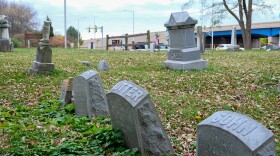They lift your spirits, prompt you to think, make you feel grateful and inspire you to do more. They connect you to our community, shining a spotlight on what's good about our city. They're stories that are Uniquely Milwaukee, sponsored by the Milwaukee Public Library.
For one weekend in Milwaukee, there is no limit to where you can go.
Well, sort of.
In any city, there are interesting places — one that are typically not open to the public. They’re spaces you pass by and say, “I wonder what happens in there.” Doors Open Milwaukee gives everyone the opportunity to act on that curiosity, with access to more than 160 locations around the city, mostly for free.
It’s an annual celebration of the city’s architecture, history and neighborhoods, and it’s back at the end of September. For this episode, I got the chance to preview one of the most popular tours during Doors Open: Milwaukee City Hall.
The structure situated on Water Street between Wells Street and Kilbourn Avenue has, among other things, marked time in Milwaukee for more than 100 years. The bell in its tour rings across the city, rippling through the air and vibrating what was once the tallest building in the world.
The Solomon Juneau Bell, named after the city’s first mayor, first rang in 1896 “and sounded continuously thereafter until the 1920s,” City Clerk Jim Owczarski told those of us who got the chance to ascend the tower and see the bell up close as part of a special group tour ahead of Doors Open.
Owczarski has held his position since 2012, and led tours of City Hall and its tower for about the last eight years. “I love this building; I was raised here,” he said. “My father would bring me here, as a child, to pay his taxes.”
Construction for the 130-year-old building started after a design contest from the Common Council and, as Owczarski explained, “was built between 1891 and 1895 for the incredible sum of about $2 million. It was a signature building from the very beginning. That was intentional. It was a statement.”
During our interview, he went a little deeper on the building, which is “beautiful, but it is intended to be functional.” He said City Hall is a special place for the people — a space built with tax dollars and open to the public for the services they need.
A few more parts of it will be open to the public Sept. 27-28 during Doors Open Milwaukee, an event started 15 years ago by Historic Milwaukee.
“We hope that Doors Open is an invitation to maybe get out of whatever your typical groove is, and go into spaces and neighborhoods that you haven’t typically spent time in before,” Historic Milwaukee events director Grace Fuhr said. “So it’s an opportunity to explore new spaces.”
Geography, neighborhood variety and partnerships are some of the ways Historic Milwaukee chooses its sites. This year, there are 165 locations. “I think this year King Drive and the Near West Side have a high concentration of locations, and we would love to continue to grow our partnerships in Milwaukee’s neighborhoods and be everywhere,” Fuhr explained.
As for favorite sites, the Milwaukee Art Museum, the Bradley Symphony Center and a home designed by Frank Lloyd Wright are among the most popular every year. Then, of course, there’s Milwaukee City Hall, where Owczarski outlined why the Solomon Juneau Bell stopped ringing in the early 1900s.
“The three reasons as to why it went silent, I’ll tell you what they are, and I’ll tell you what I think,” he tells tourgoers.
“Number one: You remember that sign I showed you downstairs? Keep strikes 15 seconds apart? This bell does vibrate the building, it’s true. I doubt that’s the reason they silenced it, although some think so,” Owczarski began.
“Number two: One of the city’s first Socialist mayors suffered from migraine headaches, and his office was straight that way. Wouldn’t surprise me at all if it annoyed him, but I don’t think that’s it.”
As for number three? “November of 1918, the U.S. participation in the first World War ends,” Owczarski said. “As a consequence of that, a wave of anti-German sentiment sweeps across America. One of the great symbols of that Germanness are bells. I think that’s why it goes silent.
“It remains that way until the mayorality of John Norquist,” he concluded, “when by public subscription and private donation they redid the structure and made sure it was sound, and also re-rigged the striker.”
There is so much more to know about City Hall, including that it was built on swampland. For the foreseeable future, Owczarski will be the person telling these stories — his pride in this building probably as strong as his dedication to Milwaukee itself. What better person to share its history?
As part of our special Doors Open Milwaukee preview, we got the chance to tour Bay View Printing, the company responsible for the beautiful graphics in the Radio Milwaukee lobby. You can check out a gallery of our tour below and learn more about visiting Bay View Printing on the Doors Open Milwaukee website.

























